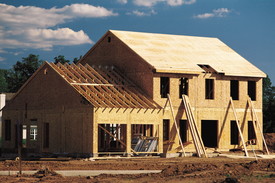 Aside from LED light bulbs, recycling and lowering home temperatures to sometimes uncomfortable levels, many homeowners are still at a loss as to how they can reduce their carbon footprint and become responsible stewards of the environment in a more meaningful, practical way. 2014 home design and construction trends promise to change this by bringing zero-sum footprint objectives to the forefront of everyday building projects with affordable and effective solutions. Hilary Jay, director of the Philadelphia Center for Architecture and co-founder of DesignPhiladelphia, tells us that the two most important building trends to emerge in the coming year are passive house standards such as “superinsulation” and vegetated permeable foundations for driveways and other paved outdoor surfaces – including those in urban areas. Whether it is for new construction or retro-fitting an existing structure, responsible and sustainable environmental practices are now becoming possible in every home, in every area.
Aside from LED light bulbs, recycling and lowering home temperatures to sometimes uncomfortable levels, many homeowners are still at a loss as to how they can reduce their carbon footprint and become responsible stewards of the environment in a more meaningful, practical way. 2014 home design and construction trends promise to change this by bringing zero-sum footprint objectives to the forefront of everyday building projects with affordable and effective solutions. Hilary Jay, director of the Philadelphia Center for Architecture and co-founder of DesignPhiladelphia, tells us that the two most important building trends to emerge in the coming year are passive house standards such as “superinsulation” and vegetated permeable foundations for driveways and other paved outdoor surfaces – including those in urban areas. Whether it is for new construction or retro-fitting an existing structure, responsible and sustainable environmental practices are now becoming possible in every home, in every area.
Passive House Standards: Superinsulation
The concept of the passive house involves a commitment to drastically reduce home energy consumption, thereby reducing the emission of greenhouse gases into the environment. According to the U.S. Energy Information Administration, the building sector is responsible for almost half of all greenhouse gas emissions and over 75% of the electricity generated in the United States. In 2014, the number one priority in meeting passive house standards is “superinsulation.” Superinsulation involves not only taking extreme care in making sure that all places where insulation meets walls, floors and roofs are airtight, but also means using the most efficient materials possible. Aerogel is one of the most effective insulators on the market today, having the highest thermal resistance and conductivity, but it is not the only option. Superinsulation can get rather technical and there are several things to consider (cost, efficacy and indoor environmental health to name a few) and so it should be heavily researched and/or discussed with your local contractor before installation. Heat recovery ventilation is also becoming a popular standard in homes as it enables homeowners to enjoy fresh air without opening doors or windows and helps to minimize issues like mold growth and airborne illnesses that can be trapped in superinsulated homes.
Vegetated Permeable Foundations
According to the Environmental Protection Agency, the number one way to reduce the pollution of our nation’s water supply is to contain storm water run-off. When heavy rains occur, excess water flows across non-permeable surfaces such as asphalt and concrete, into storm drains and along the way collects a whole host of contaminants such as chemicals, bacteria and solid waste. Since these storm drains empty directly into our lakes, streams, creeks and oceans, it is imperative that the flow be minimized and filtration be maximized.
A variety of permeable surfaces for areas like driveways have arisen over the last decade – including pervious asphalt and concrete – along with new types of foundational grids and aggregates that allow water to be absorbed back into the earth. While these have been very successful in reducing storm water run-off, they lack the capacity to filter as well as things like grass and soil and so in 2014, designers and builders have been working to integrate as much vegetation into paved surfaces as possible. Since a grass driveway is impractical, property owners are being introduced to things like open-celled paving grids that can be laid on top of turf. Irish Moss and Bent Grass are excellent turfing options, as they provide adequate absorption and filtration, but do not require constant shearing.
It is reported that permeable surfaces – even those integrating vegetation – are not necessarily more expensive than traditional pavements, so even property owners on a strict budget should consider these highly effective and environmentally sound options. Be sure to research your area’s building codes before committing to a residential or commercial project, because they do tend to vary according to things like climate and geological make-up.




























